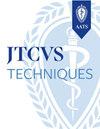Re-repair of post–myocardial infarction ventricular septal rupture
IF 1.7
Q3 CARDIAC & CARDIOVASCULAR SYSTEMS
引用次数: 0
Abstract
Background
Survivors of post–myocardial infarction (MI) ventricular septal rupture (VSR) repair may require reintervention if initial repairs are incomplete or fail. We assessed patients undergoing post-MI VSR re-repair.
Methods
Between January 1976 and July 2023, 38 consecutive patients underwent re-repair of post-MI VSR at Cleveland Clinic. Preoperative characteristics, operative details, and postoperative outcomes were obtained through medical records review, and patients were followed for survival.
Results
Thirty-two (84%) re-repairs were elective/urgent, and 6 (16%) were emergencies. Preoperative temporary mechanical circulatory support was used in 14 (37%), with 12 isolated intra-aortic balloon pumps. Indications for re-repair were recurrent VSR detected during postoperative surveillance (n = 25; 66%) and residual VSR after incomplete initial repair (n = 13; 34%). The median time from initial repair to re-repair was 55 days (15th/85th percentiles: 5-331 days). Two patients (5.3%) had residual or recurrent VSR after re-repair but received no intervention due to hemodynamic insignificance. Postoperative complications included sepsis (n = 7; 18%), stroke (n = 6; 16%), and new-onset dialysis (n = 6; 16%). Operative mortality was 32% (n = 12), with differences between patients who underwent surgery before January 2001 (n = 10/18; 56%) and those who did so after January 2001 (n = 2/20; 10%), as well as between patients who received preoperative temporary mechanical circulatory support (n = 8/14; 57%) and those who did not (n = 4/24; 17%).
Conclusions
Patients with failed or incomplete initial post-MI VSR repairs may be considered for re-repair, as modern-day improvements in perioperative care may be associated with more favorable outcomes. Referral to an expert tertiary center should be considered owing to the surgical complexity of re-repair.

心肌梗死后室间隔破裂的再修复
背景心肌梗死(MI)后室间隔破裂(VSR)修复的幸存者如果初始修复不完整或失败,可能需要再次干预。我们评估了接受心肌梗死后VSR再修复的患者。方法1976年1月至2023年7月,38例连续患者在克利夫兰诊所接受心肌梗死后VSR再修复。通过病历回顾获得术前特征、手术细节和术后结果,并随访患者的生存情况。结果选择性/紧急修复32例(84%),紧急修复6例(16%)。术前使用临时机械循环支持14例(37%),12个孤立的主动脉内球囊泵。术后监测发现复发性VSR (n = 25;66%)和初始修复不完全后残留VSR (n = 13;34%)。从初次修复到再修复的中位时间为55天(第15 /85百分位数:5-331天)。2例(5.3%)患者在修复后有残留或复发的VSR,但由于血流动力学不显著而未接受干预。术后并发症包括脓毒症(n = 7;18%),中风(n = 6;16%)和新发透析(n = 6;16%)。手术死亡率为32% (n = 12),与2001年1月前接受手术的患者(n = 10/18;56%)和2001年1月以后的人(n = 2/20;10%),以及术前接受临时机械循环支持的患者之间(n = 8/14;57%)和没有(n = 4/24;17%)。结论心肌梗死后VSR初次修复失败或不完全的患者可以考虑进行再修复,因为现代围手术期护理的改善可能与更有利的结果相关。由于手术修复的复杂性,应考虑转诊到专家三级中心。
本文章由计算机程序翻译,如有差异,请以英文原文为准。
求助全文
约1分钟内获得全文
求助全文

 求助内容:
求助内容: 应助结果提醒方式:
应助结果提醒方式:


